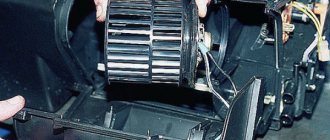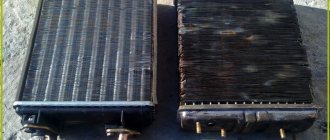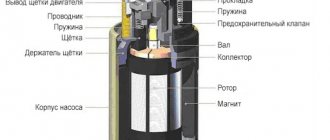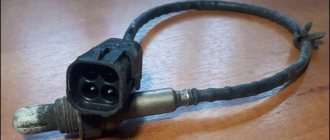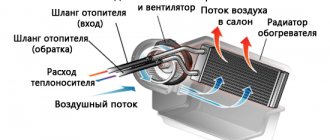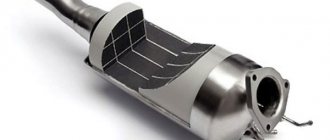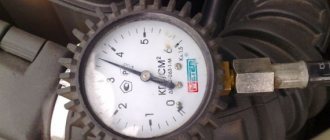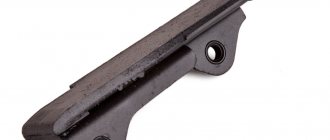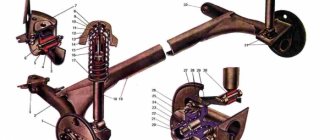Design and principle of operation of the VAZ 2107 heating system
The VAZ 2107 stove creates and maintains a comfortable air temperature in the cabin and prevents the windows from fogging in cold and humid weather. It consists of:
- heater;
- fan;
- control unit.
Outside air enters the casing of the air intake chamber located in the engine compartment under the windshield through an opening in the hood. It is then sent to the heater, where most of the moisture it contains condenses. However, until the radiator is completely warmed up, slightly humid air will enter the cabin.
The heater radiator is heated by coolant coming from the cooling system. The temperature is regulated by a special tap that partially blocks the flow of hot coolant going into the heating system. The more heated liquid enters the heater radiator, the warmer it will be in the car. The position of the tap is changed by a regulator from inside the cabin using a flexible rod .
Air enters the cabin using a heater fan, the rotation speed of which is regulated by a special resistor. When the vehicle is moving at high speed, the heating system can operate without the fan turned on. The air flow entering under the hood creates increased pressure in the air intake box and forces warm air into the cabin.
The heating system of the VAZ 2107 is quite simple (warm air flows are indicated in orange, cold air flows in blue)
Through an air duct system, heated air is directed to different parts of the cabin, as well as to the windshield and side windows, preventing them from fogging in cold and humid weather.
The operation of the stove is controlled using several knobs on the instrument panel. The upper handle regulates the position of the heater tap (the extreme left position is the valve is completely closed, the extreme right is fully open). Using the middle handle, the position of the air supply cover is changed. By turning it to the right and left, the intensity of the warm air supply increases and decreases accordingly. The lower handle regulates the dampers of the heated window ducts. In the right position, the air flow is directed to the side windows, in the left position - to the windshield.
Where is the heater radiator installed on the VAZ 2104–2107 and what functions does it perform?
The heater radiator on all classic Zhiguli cars is located in a special box under the front panel. The product is a heat exchanger, the main function of which is to transfer heat from the coolant (antifreeze) with subsequent distribution throughout the cabin. This unit works in the same way as the main radiator of the power unit. For the stove to function correctly, the heat exchanger must be constantly heated. This is achieved by connecting the radiator to the engine cooling system using tubes and rubber pipes and constant circulation of liquid through a water pump (pump).
The heater radiator on the “classic” is located in a special box under the front panel
Diagram and design of the heating system in the VAZ-2107
The design of the heating unit on “sevens” with a carburetor engine or injector is identical:
- Blower The line is aimed at blowing the windshield.
- Airflow cover.
- Radiator unit.
- Radiator protective cover.
- Heating unit faucet pull.
- Radiator outlet line.
- Underwater pipe of the radiator assembly.
- Radiator tap. Used to drain refrigerant.
- Blower Designed for blowing air flow through the glass of the right window.
- Nozzle for supplying air flow to the side glass.
- Air duct damper intended for blowing right glass.
- Additional resistor device.
- A cover located on the air flow distribution device.
- Blower damper for heating the windshield.
- Electric fan motor for heating system.
- Impeller of the ventilation device.
- Blower in the internal ventilation system.
- Cover air flow control knob.
- External blower flap control handle to direct air flow to the windshield.
- Bracket for fixing air flow control handles.
- Lever for controlling the blower flaps of the heated glass system.
- Airflow cover control handle.
- Radiator faucet control lever.
- Air flow cover pull.
- The damper rod designed to control the heated windshield.
- Left blower for heating the side window.
- Ventilation nozzles located in the center of the console.
- Nozzle blade.
- Directly the nozzle of the heating system.
- Nozzle handle.
- Toothed pulley of the damper drive device.
- Air inlet seal located at the rear.
- Air supply pipe.
- Front sealing element of the air supply pipe.
- Air supply valve.
- The latch of this hose.
- Damper equipped with a gear sector.
Diagram of the heating unit VAZ 2107
Three levers are used to control the heating system:
- The top one is designed to supply refrigerant to the radiator unit. This slider is connected to the faucet via a cable. It is mounted on the inlet line. In the extreme left position, the device does not work and the heating unit does not heat. If you move it to the right state, it will open and the coolant will enter the radiator device.
- In the middle position, it is possible to control the air flow flaps. If the slider moves to the left state, the air supply from the street is cut off. It will only circulate inside the car. When moving to the far right position, air flows from the street into the car.
- In the lower state, the damper is controlled, which is designed to distribute the air flow among the blowers. In the extreme left position, the flow flows to the side deflectors and to the center, and in the right position - to the windshield.
Each of the listed levers can be set to any state, this will allow for optimal functioning of the heating unit.
Control
The operating principle of the VAZ stove control is based on pure mechanics. Externally, the unit looks like a small panel with slider levers and a separate button that activates the fan. All this is located in the center console area, that is, at the driver’s fingertips.
The structure of the block is as follows:
- the topmost lever opens (or closes) the valve that supplies coolant;
- the slider located in the middle is connected to the air supply damper;
- lower - distributes heat over the sleeves.
The extreme left position in the first two cases means that the function is disabled, that is, the stove does not heat and air is not supplied from outside. Moving the levers to the right activates the heater or opens the damper. So, if the heater is not activated, but the air intake is turned on, then the cabin space is ventilated.
With the last, lowest switch, everything is different. If you move it to the far left position, the heat will flow to the side windows and into the center of the cabin. In the right position, hot air is directed to the forehead.
The smooth adjustment of all three sliders provided by the designers allows you to fine-tune the operation of the stove as accurately as possible.
How does the heater work?
The operating principle of the heating device is very simple. After opening the tap, the coolant begins to circulate through a large circuit and is supplied to the heater radiator. When the air intake damper is moved back, it passes into the radiator, where it heats up and is then sent to the passenger compartment.
If the car is driving fast, then the natural flow is enough for the stove to work well and effectively heat the cabin. In this case, the fan is not turned on. In other situations you cannot do without it.
Disadvantages of the heater in the VAZ-2107
The need to improve or improve the operation of the heating system may arise as a result of the following shortcomings:
- Ineffective rear airflow. Due to design features, warm air is difficult to reach passengers sitting in the back. It will take time to effectively warm up the entire interior of the car.
- There is a weak air flow from the left deflector device on the “sevens”.
- The electric motor of the heating unit is too loud.
- The faucet of the radiator device is also considered a weak point. With prolonged use, it leaks, which leads to a decrease in the volume of antifreeze in the system.
The most common problems
Thanks to its simple design, the heater of the 2107 VAZ model rarely breaks down. However, sometimes failures do happen. Most often this happens due to:
- sour faucet;
- clogged or cracked radiator;
- breakage of the cable drive.
It is the first of the mentioned elements that causes the greatest problems. The trouble is that in the winter the VAZ stove is actively used, while in the summer, of course, it sits idle for 4-5 months. Because of this, the tap often becomes clogged with solid particles contained in the antifreeze and jams. With the arrival of cold weather, it can be very difficult to open it, which is why the cable breaks or the locking fitting itself breaks. The faulty unit must be replaced.
The period of inactivity is also negatively displayed on the radiator. Without coolant circulation, deposits form on the coolant walls and oxidative processes are activated. As a result, the heat exchanger tubes become clogged, and subsequently the efficiency of the furnace as a whole decreases.
For preventive purposes, the radiator must be regularly washed with special compounds. Blockages are removed mechanically.
Leaks are another problem that often occurs with heaters. They occur due to the destruction of the faucet or loss of tightness of the joints of the pipes and radiator. The first two breakdowns are eliminated by replacing the failed element, and the last – by soldering. Fortunately, the original radiators on VAZ classics are made of copper, and therefore can be easily repaired.
Sometimes the fan also breaks. Problems here arise due to:
- motor burnout;
- wire break in the circuit;
- button failure.
Repair of heating radiator VAZ 2107
Often, repairing a VAZ 2107 stove involves replacing or repairing the heater radiator. Repair actions depend on the type and cause of the malfunction:
A clogged radiator can be flushed with water pressure. Scale on the walls of honeycombs can be removed using a special product that dissolves it.
A leak in a copper (brass) radiator can be soldered. Using a powerful soldering iron and solder, you can repair a hole or crack. Leaking aluminum radiators must be replaced.
Other problems with the heating system
Although heater radiator breakdowns occur most often, there are other malfunctions that can be easily fixed with your own hands:
- Fan motor failure. Problems are created by the rotor bushings, which on the “original” motor are made of low-quality material. As soon as the heating system fan begins to whistle, it needs to be replaced with a non-original one, in which bearings are installed instead of bushings.
- Heater valve wear. It suffers from scale, dirt, and simply wears out. Cranes are usually not repaired, but replaced. It is better to replace a faucet with a ceramic core; it is much more reliable and durable than a metal one.
- Breakage of control unit rods. Everything is clear here: what should be regulated is not regulated - check the condition of the rods and their connection. Sometimes the problem is solved in just half an hour.
More complex work, such as tuning or modifying the stove, is no longer considered troubleshooting. Of course, the stove on a VAZ opens up endless possibilities for improvements and additions, but you can get by with what you have at the moment. The main thing is that everything works as it should, and then you definitely won’t freeze in winter.
It is better to check the heating system before the time comes to use it. In the summer it is more comfortable and easier to do repairs; you can take your time and look for high-quality and inexpensive spare parts, and generally come to the cold season fully armed. In most cases, when the VAZ 2107 stove does not heat, you can correct the situation yourself. You just need to have straight hands and the desire to do the repairs correctly and efficiently.
Stove malfunctions
Due to the simple design, there are not so many faults in the interior heating system of the VAZ-2107. They are divided into mechanical and electrical. Mechanical problems include:
- jamming of the antifreeze supply valve;
- radiator clogged;
- breaks in the drive mechanism cables;
- smudges.
The tap and heater radiator are the “weak” points in the VAZ-2107 stove. If in winter the tap works frequently, then with the onset of summer it turns off and remains in that position. Because of this, it jams, and when winter comes, attempts to open it lead to a break in the control cable.
Video: The heater on the classic VAZ 2101-07 does not work. We are looking for the reason.
It is difficult to “move” a faucet that is stuck in one position, so it is easier to replace the faulty unit. And cutting off the antifreeze supply also affects the radiator. The absence of fluid movement for a long period (when operating a car in the summer, when the stove is not in use) leads to intensive formation of oxides inside the radiator, which clog the heat exchanger pipelines. Because of this, the throughput of the radiator decreases, and with it the performance of the stove.
A clogged heater radiator is washed, but if there are a lot of deposits, then they can only be removed mechanically, and for this the radiator is unsoldered. Soldering it back is difficult and sometimes it is easier to replace the heat exchanger than to wash it.
Leaks are also a common failure. They occur at the junction of the pipes, and also if a crack appears in the radiator. In the first case, the leak is eliminated by tightening the fastening clamps, in the second - by soldering or replacing the radiator.
Electrical faults include burnout of the electric motor, open circuit of its power supply and breakdown of the control key.
Heater assembly VAZ 2107
The repair of the VAZ 2107 stove is completed by assembling the heater. They assemble it in the reverse order of disassembly. The work has a number of features:
- rubber gaskets must be replaced with new ones and lubricated with silicone sealant;
- before assembling the heater, it is necessary to attach the pipes and tap to the radiator;
- Do not overtighten the nuts so as not to crush the gaskets;
- before putting on the rubber hoses, the outer surface of the metal radiator pipes must be treated with sealant;
- After the VAZ 2107 heater is assembled and connected, you must remember to add antifreeze to the system and check its tightness.
Important: repair of the VAZ 2107 stove must be carried out in conjunction with checking the serviceability of the engine cooling system components. This approach allows you to accurately determine the cause of the breakdown and reliably eliminate it.
Malfunction of the mounting block of the VAZ 2107 stove fuse
If the fan noise is not heard when the heater switch button is pressed, then the first thing to start examining is to check whether the VAZ 2107 F1 heater fuse is working (they are signed and marked on the cover) in the mounting block. In addition to the stove, it is responsible for the operation of the rear window defroster and reversing lights. In most cases, the serviceability of the fuse can be assessed by looking at it through the light, but sometimes it happens that it is simply not visible, in which case it is better to have a “control” or tester on hand.
Diagnostic devices
To check, connect one probe to the battery, touch the fuse with the second, and touch the free end of the fuse to the second terminal of the battery. If the fuse is good, the light will light up.
Follow the manufacturer's recommendations and install similar fuses, in this case 10 amps.
When F1 is operational during diagnostics, but there is no voltage on the blue-yellow wire of the switch, there is probably a break in the tracks in the mounting block itself. It can be repaired, but you will need tools and soldering skills, or you will have to replace it with a new one. Read more about the VAZ mounting block in the article.
Dismantling the heating radiator VAZ 2107
To do the job you need a Phillips screwdriver and a set of wrenches (open-end and socket).
Sequence of operations:
- loosen the heater hose clamps located in the engine compartment;
- remove the hoses from the heater radiator pipes (this may result in a slight leak of antifreeze);
- unscrew the screws securing the rubber seal;
- remove the seal;
- unscrew the radio panel;
- disconnect the cable from the tap of the VAZ 2107 stove;
- Using a screwdriver, remove the brackets on the fan casing;
- lower the casing down;
- remove the heater radiator.
Step-by-step instructions for replacing the radiator
What should I do to get the stove working again? First of all, replace or repair the radiator; to do this, follow these steps step by step:
- Drain the coolant into a container.
- Unscrew the 2 clamps located on the pipes of the old device from the engine compartment and remove the hoses.
- Unscrew the rubber seal retainer and then remove it completely.
- The interior of the VAZ-2107 will also have to work. Remove the panel where the radio is located, using a screwdriver or a 7mm wrench, unscrew the fastening element of the heater valve drive cable.
- Don't put the screwdriver down; you'll still need it to remove the spring-shaped brackets. There are four of them, the parts are located on the casing of the ventilation equipment.
- Slightly lower the cover downwards and then move it to the left.
- The radiator can now be pulled out.
- Proceed to inspect the old unit. Which product can not be changed? If there are no traces of leaks on the metal tubes, there is no corrosion. Corrosion is cleaned out, and leaking metal pipes are replaced. It happens that the heater tap lever is jammed, the point is that it no longer opens or there are problems with closing. When reinstalling radiator components, remember that good gaskets seal the fit of the parts to each other. Each gasket should be covered with silicone sealant; screw them securely, but without overtightening the fasteners.
- Rubber hoses that carry coolant along the entire path are also subject to lubrication with sealant.
- Assemble and mount the radiator exactly as indicated in the instructions, but in reverse order.
- If necessary, add antifreeze.
- All that remains is to turn on the ignition and check how tight the connection of the pipes with the hoses of the VAZ-2107 is.
What to do if the stove in the VAZ-2107 does not heat and the radiator is to blame is shown in the video: https://www.youtube.com/watch?v=gGOGR8EeHWI.
Stove modernization
Very often, in parallel with the prevention of stove malfunctions and its settings, the driver modernizes the heating system for more efficient operation.
Most often, for these purposes, the standard fan and resistor are replaced with products from the figure eight. The new fan is larger in size, due to which a larger amount of warm air is supplied, and the vehicle interior warms up faster. The new fan fits into the standard seat with virtually no modifications. It is only necessary to cut off one of the aerodynamic ridges from the impeller. After such improvements, it will also be necessary to replace the standard fan button with a product from the figure eight.
Sometimes, for better airflow of the driver’s side windows, additional small fans are installed in the deflectors. Such improvements, combined with preventive maintenance, will ensure comfort and warmth in the cabin even in the coldest times.
Heater modernization
All car enthusiasts know that the design of the VAZ 2107 stove is imperfect, and at the same time it operates with noticeable noise even in the cabin. Therefore, this part of the car heating system is very often modernized. Many people try to improve the operation of the stove on their own, but most often this does not produce the desired effect. With your own hands, even knowing how to remove the VAZ 2107 stove, you can only seal the joints of the air ducts and nozzles, as well as redistribute the hot flows. However, this causes the temperature in the cabin to remain largely the same. To keep your car warm and cozy during the winter cold, you need to increase the amount of heat supplied by the radiator. The whole problem is the stove fan, which is too small and does not create the necessary air flow. In this regard, as a rule, the first step is to replace the fan of the VAZ 2107 stove.
If we compare the operation of this mechanism in two models of Zhiguli cars, we can see that the heater motor of the seventh model of Zhiguli, while rotating at a frequency of about three thousand revolutions per minute, consumes about four and a half amperes of current. And on a G8 fan at four thousand or more rpm, three and a half times more is consumed. That is why modernization is necessary. Sometimes it is even necessary to replace the radiator of the VAZ 2107 stove.
The procedure for modifying the heater
If the VAZ 2107 stove does not heat well, remove the casing in the passenger compartment on the bottom of the stove, on which the fan is mounted on top. The latter is completely removed due to its uselessness. After this, one of the aerodynamic ridges is carefully cut off, which supplies warm air towards the feet of the driver and the passenger sitting next to him. This is especially true when installing a fan with a VAZ 2108, since its motor is slightly longer. The impeller can be completely removed, and its functions can be transferred to a five-blade standard fan.
The hole for this purpose increases slightly in diameter so that a new shaft can be installed into it. It is important to ensure that the updated structure is “fitted” into place tightly and securely. Immediately before installing a new fan, you need to directly connect it to make sure it is working.
How to identify the problem and fix it
There are several reasons why the furnace blows cold air or does not work at all. In this case, you must proceed as follows:
- Check the faucet to see if it opens.
- Is the cold air damper capable of closing?
- With the car running, check the heater (heater radiator) for heating.
Radiator replacement
If the problem is in the radiator and it needs to be replaced, then proceed as follows:
- Drain the liquid.
- We unscrew the two clamps from the engine compartment, which are located on the radiator pipes. We remove the hoses.
- Unscrew and remove the fasteners on the rubber seal.
- We dismantle the radio panel and the cable fasteners on the heater valve drive. To do this job you will need a 7 key.
- Next, use a screwdriver to remove 4 spring clips from the fan casing. The casing drops down and slides to the left, after which the radiator can be pulled out.
- Now you can carefully examine the radiator, revive it or replace it with a new one. Assembly is carried out in the reverse order and does not involve any difficulties.
A broken radiator is a common cause of a non-functioning stove.
Restoring glass blowing
The stove that is installed on the VAZ-2107 has some design features, due to which the left pipe often does not blow the glass well enough. To put up with such an inconvenience in winter is difficult. Therefore, it is worth working to eliminate this problem. You must proceed according to the following scheme:
- We remove the deflector from the pipe by prying one of its sides with a screwdriver.
- The deflector body is held on the torpedo using small antennae. We put our hand inside and pull it out.
- The 50mm fan from the computer must be placed in the center of the dismantled case and marked in the appropriate places.
- In the plastic case, using a utility knife, hacksaw or sharp knife, cuts are made at the marks.
- The plastic easily breaks off along the line of cuts and an opening is obtained into which the fan is installed. It should fit snugly in place.
- We return the insides of the deflector to their place. The internal blades will not be able to rotate at full speed due to the changes made.
Other minor faults
Finding and fixing minor problems on your own is a handy skill for any car enthusiast.
After such actions it will be easy to determine the causes of the breakdown. And they can be as follows:
- If the faucet is working properly, but the heater heats up only at high engine speeds and under such conditions begins to blow warm air, then the fault should be looked for in the pump or a coolant leak. To find a leak, you must carefully examine the required area of the cabin. If leaks are found, the hoses need to be replaced, tightened or new clamps installed. Do not neglect the cap on the expansion tank. Tightness is the main condition under which the heater can function normally.
- Leaks can also occur due to rusting of the radiator, taps and other elements of the heating system. In this case, it is enough to simply replace the necessary part and enjoy a comfortable ride.
- The tightness can be checked in another simple way. Turn on the engine and wait 10 minutes. During this time, the expansion tank should warm up. If this does not happen, then we can talk about the lack of pressure that is necessary to supply antifreeze or antifreeze to the heater stove.
- If you notice that the car gets very hot when standing in a traffic jam, then you can talk about the lack of necessary pressure.
- The stove can become clogged with various debris and become coated from the inside with oxides of various substances. In this case, it is necessary to clean out the debris and clean the system.
The car owner must be prepared for minor problems and be able to quickly fix them. For example, with the onset of winter, many VAZ-2107 owners’ stoves do not heat up and it is not always convenient to run to specialists with this problem.
Repair
As we have already noted, the design of stoves on dozens with carburetor and injection engines has practically no differences. Therefore, the repair instructions below are suitable for owners of a VAZ 2110 with both types of power units.
If you are planning to overhaul your old-style stove, we recommend starting with the purchase of a radiator. Use copper as it is more efficient and helps the heater work better.
To carry out repairs correctly, strictly follow the points presented in our instructions and rely on video materials.
- There is a plug on the engine block through which coolant is drained into any container. If you plan to use the same antifreeze or antifreeze again, choose clean containers.
- Next you need to move the frill forward. This process will take quite a long time, so be patient.
- Next, you need to remove the windshield wipers and get rid of as much as possible of everything that could interfere with the repair process.
- Remove the body of your stove. It is divided into two parts, which is important to know in advance. The front part of the stove body is removed directly along with the fan.
- After this comes the stage of dismantling the cabin filter. Check its current status. If the filter is dirty, this is an excellent reason to replace it.
- The next stage involves removing the second part of the housing.
- Loosen the clamps used on the hoses a little. This will allow you to easily remove the hoses.
- Having applied some effort, you can now finally remove the radiator from its seat.
Reassembly
In fact, reassembling the unit only involves following the opposite sequence of operations. By disassembling the stove, you have the opportunity to simultaneously inspect other elements of your car to make sure they are working.
The only nuance that you should pay attention to when reassembling is the type of stove. If you have an old-style heater, then it is important to pay attention to a couple of issues.
- When the plastic housing is mounted in place, make sure that the pedal fits neatly into the groove intended for it.
- Check how tightly all the nodes fit into their seats. Otherwise, unpleasant consequences may arise that will force you to dismantle the entire assembly again. And this, as you already understand, is not an easy process.
That's it, now all that remains is to return the coolant back into the system and tighten the plug securely. Test your vehicle in a garage before driving it on public roads.
Reasons for replacing the stove on a VAZ 2107
Many car problems occur with the arrival of cold weather, and this especially applies to cars from the domestic auto industry. One of the main problems is the inefficient operation of the heating system, as a result of which the windshield and side windows are poorly heated. VAZ 2107 owners quite often encounter a situation where in winter the car’s interior simply does not warm up. In this case, there is no need to talk about any comfort for passengers and the driver. To understand the reasons and eliminate a possible malfunction, you first need to understand the design of the “seven” heater.
The main elements of the VAZ 2107 stove are:
- radiator;
- tap;
- fan;
- control cables;
- air ducts
Parts of the heater and body ventilation of the VAZ 2107: 1 — lever of the air distribution cover; 2 — bracket for control levers; 3 — handles of heater control levers; 4 — air duct for heating the side window; 5 - flexible rods; 6 - heating air duct
As the vehicle is used, certain malfunctions may occur with the stove, which reduce the efficiency of the unit or make its operation completely impossible. There are not many signs of major problems and they boil down to the following:
- heater leak;
- lack of heat or weak air heating.
As for the service life of the stove, it is inappropriate to give any figures. It all depends on the quality of the parts, the coolant used, as well as the frequency of operation of the car.
Radiator leak
If the heat exchanger is leaking, it won’t be difficult to detect. Coolant in the form of a puddle will be under the feet of the driver or passengers. However, you should not rush to conclusions and buy a new radiator to replace it. The leak may be associated not only with it, but also with leaky pipes or faucets. To do this, you need to get close to these elements and carefully examine them with good lighting. Having made sure that the problem is not in them, only the radiator remains. By the way, sometimes when a leak appears while the heater fan is running, the windshield fogs up and a characteristic smell of antifreeze appears. Having found out that the reason lies in the heat exchanger, it will need to be removed and then repaired or replaced with a new one.
If a radiator leaks, the part needs to be repaired or replaced.
The stove doesn't heat
If the engine is warm, the heater valve is open, but cold air is coming from the heating system, then most likely the radiator is clogged or there is a low level of antifreeze in the cooling system. To check the coolant level, just look at the level in the expansion tank or unscrew the main radiator cap with the engine off. If there are no problems with the level, then you need to deal with the heat exchanger, you may have to flush it or the entire cooling system. To avoid possible clogging of the heater radiator, you should not add various additives that eliminate small leaks. Such products can easily clog the stove tubes.
Cold air flow from the heating system can also be caused by air in the system. In this case, you will need to remove the air plug and add coolant.
Airing is the appearance of an air lock in the cooling system during repair work or when replacing the coolant.
The heater tap may fail over time as a result of scale formation.
In addition, the problem is possible with the tap itself, which over time can become clogged or scale may form if water is used instead of antifreeze. If there is a problem with the tap, the part is disassembled and cleaned or simply replaced. Another, although rare, but possible cause of a cold stove, may be pump failure. In this case, the engine warms up, but the pipes going to the heater radiator remain cold. In this case, the water pump must be repaired immediately. Warm air may also not enter the cabin due to problems with the heater fan. The problem may be with the motor itself or its power circuit, for example, if a fuse blows.
Why might the stove not heat up?
So, the stove does not work, it blows cold air. Since this system is quite simple, there are not many possible breakdowns, and many of them can be eliminated without incurring huge costs.
Main malfunctions and ways to eliminate them:
- Airing the system. If the antifreeze has recently been replaced, there may be an air lock in the stove system, as a result of which it will heat very poorly. In this case, you need to open the heater valve, and then carry out the standard procedure for removing air from the cooling system.
- There is scale on the heater tap, which prevents antifreeze from flowing through it. A faulty faucet prevents you from turning the stove on or off. Plain water may be the culprit of the problem if the car owner used it as a coolant in the summer. Deposits clog the tap hole and it has to be cleaned or replaced.
- There is scale or dirt in the heater radiator, while the underwater pipe is hot and the outlet pipe is cold. The formation of sediment is a natural process, even if you use only high-quality antifreeze. But VAZ drivers often make do with plain water, which causes corrosion of the metal elements of the cooling system. Rust settles in radiators and gradually damages them. You will have to remove the stove and try to clean it, and if that doesn’t work, then replace it.
- The pump does not pump. This is already serious, and is fraught with not only discomfort during the trip, but also overheating of the engine. The pump breaks down from scale deposited on it, the impeller can be worn down by solid particles and simply fail due to age. You need to check the condition of the drive belts, and if they are in order, replace the pump itself.
- In the heater radiator, the heat exchanger partition, which distributes the flow of liquid, has shifted. In this case, the antifreeze will enter the side tank of the radiator and immediately exit through the second pipe, without entering the honeycomb, then both pipes will be hot, and the radiator itself will be cold. It will have to be replaced; it cannot be repaired.
Repair and replacement of individual heating system elements
In addition to the radiator, the heating system includes a fan with an electric motor, a tap and a control unit.
Drivers who have been driving Zhiguli cars for many years often say that the VAZ 2107’s stove sometimes does not heat well. The most common cause of malfunctions in a system such as the VAZ 2107 stove is a leak in the radiator, as well as in pipes, taps and connections located directly between them. To this can be added switch failures for electric fan modes, damage to the device wires or oxidation of their components.
Fan motor
The electric motor of the stove is considered one of the weakest points of the VAZ 2107. This is due to the material of the bushings on which the rotor rotates. When these bushings wear out, the fan operation is accompanied by a characteristic whistle. This happens after two to three years of using the car. The electric motor can be brought back into working condition by cleaning and lubricating. However, after a short time the whistle from the stove fan will appear again. In such cases, experts recommend replacing the standard electric motor with a new one - a bearing one . As a result, the whistle will disappear, and the reliability of the unit will increase. The replacement process is associated with certain difficulties, since the electric motor is located in a rather inaccessible place. Nevertheless, after installation, the bearing motor is guaranteed to work for several years.
The factory electric motor of the VAZ 2107 heater fan is usually replaced with a bearing one
Heater valve
The heater valve is replaced when it jams, leaks, or in other cases when repair is impossible. Experts recommend installing a ceramic faucet in this case.
The metal heater valve usually opens in the fall and closes in the spring. During periods of inactivity, it can sour, become covered with scale and simply fail. The result can be extremely unpleasant for the car owner. These disadvantages do not exist with a ceramic faucet. There is practically no scale accumulation on ceramics, and it is not subject to corrosion. As a result, even after a long period of inactivity, the heater valve will be in working order.
The standard faucet of the VAZ 2107 stove is often replaced with a ceramic one
Control block
The heating system is controlled from the interior of the VAZ 2107 by several levers on the instrument panel, connected to the controlled elements by a flexible rod (steel wire). Using these levers you can:
- adjust the degree of opening of the air dampers;
- open and close the heater tap;
- distribute air flows between the windshield and side windows;
- take air from the engine compartment.
Each of the control unit levers is responsible for the operation of a specific unit.
In addition, there is also a lower damper (air distribution cover), which is controlled by a special lever located under the instrument panel on the driver’s side.
Sources
- https://bumper.guru/klassicheskie-modeli-vaz/sistema-ohdazhdeniya/pechka-vaz-2107.html
- https://legkovmeste.ru/avto/zamena-radiatora-pechki-vaz-2107.html
- https://avtozam.com/vaz/2107/dorabotka-pechki-vaz2107/
- https://ladaprofi.ru/vaz-2107/kakovo-ustrojstvo-pechki-na-vaz-2107.html
- https://semerkavaz.ru/raznoe/pechka-vaz-2107/
- https://VazNeTaz.ru/ne-greet-pechka-vaz-2107
- https://remam.ru/vozdsys/shema-i-ustrojstvo-pechki-vaz-2107.html
- https://remam.ru/vozdsys/vaz-2107-ne-greet-pechka.html
- https://autoclub.su/kak-snyat-pechku-na-vaz-2107/
Improvement of the heating system
The design of the VAZ 2107 stove is far from perfect. Therefore, car owners modify it in a variety of ways. First of all, attempts are being made to improve the tightness of air ducts, especially at joints. This allows you to slightly increase the efficiency of heating the interior.
VAZ 2107 owners modify the heating system in a variety of ways
Fan replacement
Often, to improve the operation of the stove, car enthusiasts replace their original fan with a more powerful one, used in other VAZ models (for example, VAZ 2108). The factory fan motor is mounted on plastic bushings, which wear out quickly. As a result, shaft play appears, and a whistling noise becomes audible in the cabin when the fan is operating. Repair and lubrication of bushings in this case, as a rule, do not bring the expected effect. The VAZ 2108 fan electric motor is mounted on bearings. Therefore, installing it in the VAZ 2107 stove will not only increase the efficiency of heating the interior, but will also make the operation of the fan more reliable.
Usually, along with the fan electric motor, a number of other elements of the stove control unit are also changed . The rotation speed of the VAZ 2107 factory fan at a current of 4.5A is 3000 rpm. The VAZ 2108 electric motor consumes 14A at a frequency of 4100 rpm. Therefore, when replacing, you should install the appropriate fuse, resistor (usually from a Niva) and speed switch (for example, from a Kalina).
Video: modification of the VAZ 2107 stove
To dismantle the fan you will need:
- flat and Phillips screwdrivers;
- keys for 7 and 10;
- round nose pliers.
The fan is removed in the following order.
- The instrument panel, shelf and glove box are dismantled.
- Use a 7 key to loosen the casing of the air damper control cable. The cable loop is removed from the lever.
- Use a 10mm wrench to unscrew the nut securing the heater housing.
- Use a flat screwdriver to remove the left and right air ducts from the heater body.
- Use a flat-head screwdriver to remove the latches that secure the fan to the stove.
- The wire terminals are disconnected.
- The fan is removed from the stove body.
- The impeller is removed. If necessary, use pliers.
The size of the new fan (from VAZ 2108) is slightly larger. Therefore, its installation will require some changes in the design of the stove. If only the motor is changed, it will be necessary to make an additional hole in the grille through which warm air enters the lower part of the cabin. If this is not done, the motor housing will rest against the grille.
Replacing the stove body
When installing a fan from a VAZ 2108, you will need to make a new frame, usually from plexiglass. This is quite labor-intensive and will require certain skills.
The material for a homemade frame when modifying the stove can be plexiglass
When making a new frame, all dimensions must be strictly observed. The slightest inaccuracies can lead to vibration or failure of the new fan. Having assembled the structure, you should lubricate the joints with sealant and install the new housing in place. After this, the noise level in the cabin usually decreases, and the stove begins to heat the air better.
The air intake should ALWAYS be from the street, especially in winter, otherwise the windows will sweat (and freeze in winter). Air intake from the cabin is done only when the air conditioning is turned on (in the seven this issue does not arise). The fact that one “sleeve” is not blowing is possible: a) when tampering with the stove, the sleeve did not fit into the right place and the stove is blowing somewhere under the panel, b) some kind of crap got into the nozzle (foam rubber or something like that ).
Anakin
https://forums.drom.ru/russian/t1151720023.html
When making a new frame for the motor, all dimensions must be strictly observed.
Other stove tuning options
Sometimes the design of the air ducts is modified. Additional holes are made in the stove body into which plumbing hoses are inserted. Through these hoses, connected to the side and bottom air ducts, when the engine is running, an additional flow of warm air is created onto the windows and into the legs.
Often the cause of poor interior heating is a clogged heater radiator. The coolant begins to circulate more slowly or completely stops circulating through the heating system, and the efficiency of air heating decreases noticeably. Usually in these cases the radiator is replaced with a new one.
A clogged heater radiator leads to a decrease in the efficiency of heating the interior.
